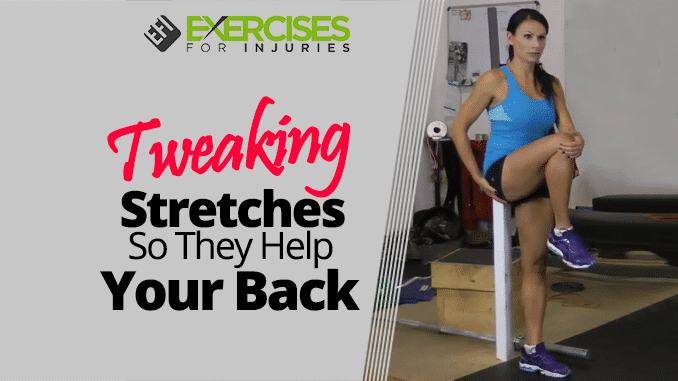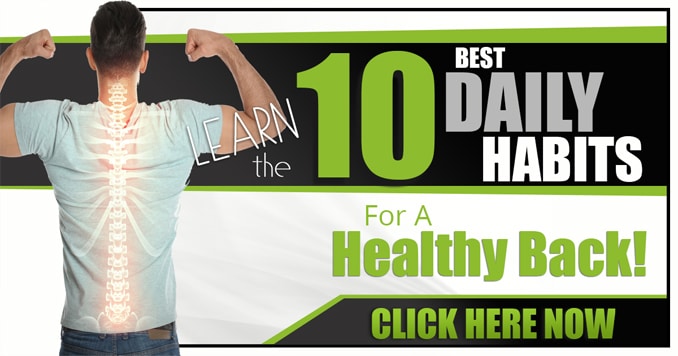
Tweaking stretches can manage tight muscles, stimulate a range of motion, and reduce stress—all things good for your body when you have back issues.
You can tweak stretches, so they help your back instead of hurting it.
I wanted to answer a Fix My Back Pain customer’s question. The Tweak Performance Stretch and the Tweak Hamstring Stretch. It was a kind of clarification when it came to the standing.
Here is Justin’s question:
“Hi, Rick. When performing the tweak standing performing Stretch, I am not sure where I am supposed to feel the Stretch to concentrate on it. Would I feel it in the hip, the glut area, or somewhere else? The only tension I feel is in the front of the pelvis area.”
I will get Orsy to go through the Stretch I am talking about, where it’s bringing one knee up and then bringing it across with the opposite hand. You are bringing it from here to the opposite shoulder and looking for a light stretch in the hip area.
Now, if you don’t feel that tweaking stretch, you can change where you pull that knee. I can pull it towards the armpit, and I can pull it towards the shoulder so I can change the angle and what I am looking for is to feel it in the hip.
You put your leg down. I want to find out exactly where I stand, offloading my leg. If I rotate my hip in and out and I put my finger in my hip joint area, I will kind of get to the ball of the hip joint, and what I should feel is that’s the area I want to stretch out, so that is where the performing muscle is.
Overlap Hip Flexor Stretch
If all you feel is in the front of the hip, what that means is you have an overlap hip flexor stretch or rectus femur. What we need to do is work on loosening that up. I would start with Foam Rolling or the hip flexor stretch before doing a Performance stretch.
Hip Flexor Stretch
I am looking for a stretch in the hip flexor. I will get Orsy to do a typical Hip Flexor Stretch. She’s contracting that glute, bringing that hip forward, and stretching out that right leg that gives it a good stride.
Another thing is if I don’t feel it, I can rotate that hip in or out to change the angle that I am stretching at.
I am looking at two things: I alternate both sides holding for about twenty seconds and loosening up that hip flexor, and Foam Rolling out that hip flexor and quad.
I am going to get Orsy to go through that again, and then you can see if that has decreased the sensitivity in that hip and allowed her to get to that performance muscle better. So give that a go, Justin.
Tweaking Stretches: Stand up and shake it out
Sitting down, stretching, and calling it a day is easy. But you know it’s more important than that. You need to move around and stretch out your muscles. You can stand up and move around for a few minutes when you get to work. Stand up and walk around a few times during the day, or even do a short exercise routine while you’re at your desk (make sure to pick things that won’t hurt your back).
This is a great way to warm your muscles up, ready to work less painfully. This is especially helpful if you sit all day. Sitting puts you in a static position that doesn’t let your muscles move freely. This can cause them to cramp up, get stiff, and hurt. By standing up, you give your muscles a break. They relax a bit and are ready to help you for the rest of the day.
Tweaking Stretches: Bend your knees when you can
Many of the stretches you’ve heard of involve bending at the waist. You’ve probably been instructed to do those on your knees. But it would be best if you bent your knees when you could. This helps take some stress off your back since bending at the knee is a better position for your spine. This is especially important if you have back pain and are stretching to help with it. Picking a stretch where you must bend at the knee is a good idea. Talk to a physical therapist if you don’t know where to start with your stretches and which ones are best for your back. They can help you pick the most helpful ones for your specific situation.
And then the second part of Justin’s question:
“During the standing hamstring stretch, I feel it more in the calf area. I have been playing with bigger and smaller steps forward, but it doesn’t seem to make a difference.” Any tips to focus on the hamstring as intended?
Leg out in the front, bending through the waist, and then look for the Stretch in the Hamstring area. This is the Stretch that Justin is talking about. I will get Orsy to do it.
If all you feel is all in the calf area, I will start with the Calf stretch or Foam Rolling Out that Calf. I will get Orsy to go through a good calf stretch.
Soleus Stretch
We will start with the leg straight to focus on the calf area, twice on each side for twenty seconds. Then we will move to a Soleious stretch, cut the distance in about half, and then both knees are moved to squatting down.
I loosened up the calf and Soleious, and then I would go through that hamstring stretch. Now I will end up feeling that I got the calf’s belly. Just underneath that belly of the calf, I will feel a light stretch. It tends to be about 25% as intense as the calf stretch.
I will get you to do a Standing Hamstring Stretch.
And as Orsy does that, I will step over and grab the Foam Roller. Regarding the 2 Foam Rolling exercises that I will get you to do.
Foam Rolling Exercises
I would do a Calf Stretch with a Foam Roller for the calf stretch. I will prop myself up and go from just below the knee joint to the heel, about five repetitions to loosen up that calf area. If I loosen this up, I can target the hamstring better.
For the one we were talking about, the performance, Rolling Out that Quadriceps. I would go from the thigh and roll up to the top of the hip and then back just above the knee and roll through it for about five repetitions back and forth.
There you go, Justin; I hope those answer your questions. Please give this a go, give me your feedback, and let me know how this goes.
Plan Which Stretches You’ll Do Beforehand
Before stretching, plan which stretches you’ll do and in what order. Try to follow a sequence that starts with your hips and works up to your upper back and shoulders. If your hips are tight, starting your stretching sequence from the ground up is best. Focus on your feet and toes, then your calves, hamstrings, and finally, your glutes. Beginners often start their stretching sequence from the top down, but this can make tight muscles in your lower body feel even tighter due to their position above your hips.
This is Rick Kaselj from ExercisesForInjuries.com
Take care and bye-bye.
Rick Kaselj, MS









